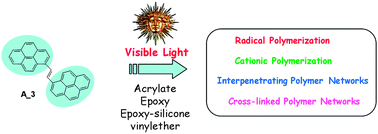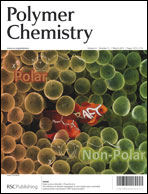New insights into radical and cationic polymerizations upon visible light exposure: role of novel photoinitiator systems based on the pyrene chromophore†
Abstract
New aromatic derivatives PyD based on a pyrene moiety are proposed here as new photoinitiators (PIs) in multi-component systems (with an iodonium salt, a sulfonium salt and optionally a silane) for the radical polymerization of acrylates and the cationic polymerization of epoxy, epoxy-silicone and vinyl ethers. These new photoinitiators allow the use of a long wavelength excitation (using visible light delivered by a halogen lamp, a laser diode at 457 nm or a Xe–Hg lamp). Excellent polymerization profiles are obtained. For polymerization processes using pyrene, very low conversions are reached in agreement with the lack of absorption of this compound for λ > 380 nm i.e.PyDs are attractive compounds for visible light. Acrylate–epoxide, acrylate–vinyl ether and vinyl ether–epoxide blends are also easily polymerized i.e. for the synthesis of interpenetrating or crosslinked polymer networks. The initiation step mechanisms analyzed by ESR, fluorescence, steady state photolysis and laser flash photolysis experiments are discussed.


 Please wait while we load your content...
Please wait while we load your content...